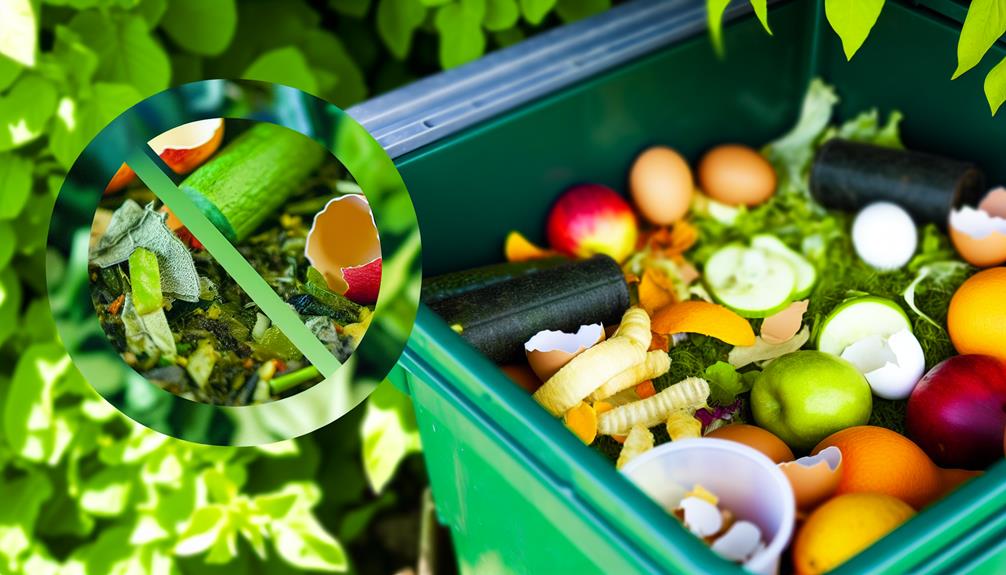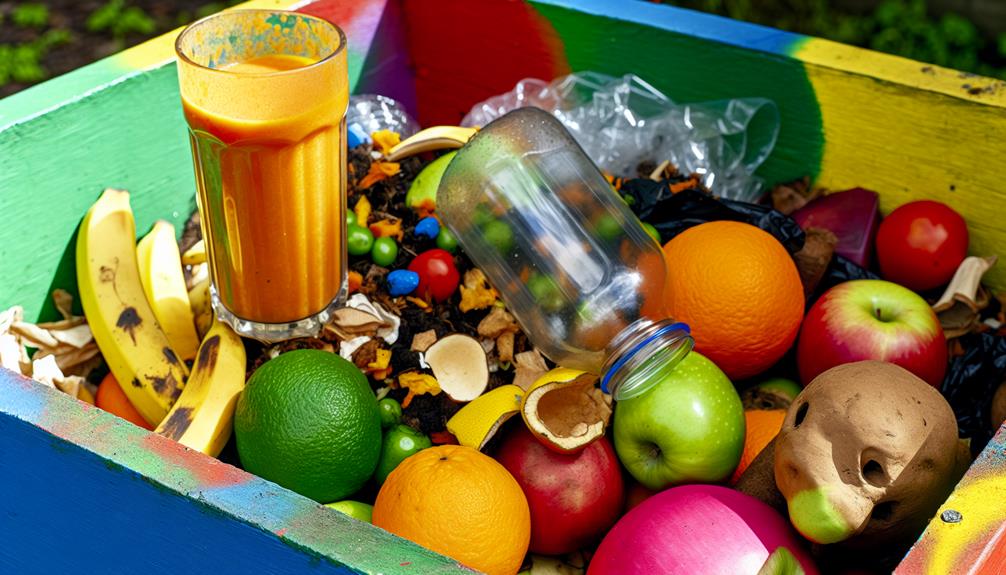

Yes, you can explore compost leftover smoothies to enrich your soil and cut down on waste. Choose plant-based ingredients and avoid dairy products, processed sugars, and excessive citrus fruits to maintain your compost balance. To compost, mix your smoothie with dry materials like leaves for proper decomposition.
Regularly rotate your compost to guarantee even breakdown and avoid excess moisture. Using leftover smoothies in composting supports a greener lifestyle and boosts your garden’s health. If you want to investigate further, you’ll discover more tips for successful composting and ways to avoid common mistakes.
To confirm if a smoothie is compostable, you need to evaluate the ingredients and their ability to break down naturally. Start by examining what goes into your smoothie. If you’re using natural ingredients like fruits and vegetables, you’re on the right track. Most of these components will decompose well in a compost pile.
Blender residue, often left behind after making a smoothie, can also be composted. This residue usually consists of tiny bits of fruits and vegetables that didn’t fully blend. Toss this residue into your compost bin; it will break down just like the rest of the organic matter.
Fruit peels are another key component. If you’re adding whole fruits to your smoothie, don’t forget that peels, like those from bananas or apples, are highly compostable. These peels provide essential nutrients and help maintain moisture in your compost pile. Just make sure that the peels are free from any stickers or non-organic matter.
By composting your leftover smoothies, you can enrich your soil with essential nutrients, making it more fertile for your plants.
Moreover, you’ll noticeably reduce the amount of organic waste that ends up in landfills.
This simple practice benefits both your garden and the environment.
Composting smoothies transforms your kitchen scraps into a nutrient-rich soil boost that enhances plant growth and vitality. By adding your smoothie leftovers to your compost pile, you’re contributing to soil enrichment and fostering beneficial microbial activity.
These microbes break down organic material, releasing essential nutrients back into the soil. Your plants will thrive with this crucial fertilizer, giving you a greener, more productive garden.
To get started, simply pour your leftover smoothies into your compost bin. Make sure to balance them with dry materials like leaves or paper to maintain the right moisture level. This mix encourages a healthy compost environment where microbes can flourish. Avoid adding too much liquid at once to prevent sogginess, which can lead to unpleasant odors or slow decomposition.
Incorporate your smoothie compost into your garden soil by mixing it thoroughly. This will help distribute the nutrients evenly and support plant roots. Over time, you’ll notice richer, darker soil that retains moisture better and promotes strong plant growth.
Composting smoothies not only recycles your kitchen waste but also provides a cost-effective way to boost your garden’s health and productivity.
Reducing waste is another key benefit of composting your smoothie leftovers. By composting, you guarantee a minimized need for additional food storage space in your fridge or pantry. This means you can buy only what you need and avoid letting ingredients go to waste. Plus, you’ll become more efficient with your blender, as every part of your smoothie creation is put to good use.
When you compost smoothie remnants, you contribute to a sustainable cycle that benefits the environment and your garden. Instead of tossing banana peels or spinach stems, you turn them into nutrient-rich compost, reducing landfill waste and greenhouse gases. It’s a small but impactful step toward a greener lifestyle.
To get started, simply set aside a container for your smoothie scraps. Whenever you blend, place peels, cores, and other leftovers into this container. Once it’s full, transfer the contents to your compost bin or pile. Make sure your compost has a balanced mix of greens (like fruit and vegetable scraps) and browns (like leaves or paper), and turn it regularly to speed up decomposition.
Also Read: Can You Compost Blood?
When composting smoothies, you should be cautious about including dairy products, as they can attract pests and produce foul odors.

Processed sugars can disrupt the composting process and harm beneficial microorganisms.
Additionally, limit the use of citrus fruits because their acidity can slow down decomposition.
Many dairy products, especially those high in fat and sugar, should be avoided when making composting smoothies. While composting dairy might seem like a good idea, it introduces several fermentation risks that could disrupt your composting process. Dairy products like milk, cheese, and yogurt can attract unwanted pests and produce foul odors as they break down. These items also create an imbalance in the compost pile, slowing down the decomposition of other materials.
These options don’t pose the same risks as traditional dairy and can provide similar benefits without the downsides.
When thinking about what to add to your composting smoothies, stick to plant-based ingredients. If you want to add some creaminess, consider using alternatives like almond milk or coconut milk.
It’s crucial to maintain a balanced compost pile to guarantee efficient breakdown. Adding too many dairy products can introduce excess moisture, creating an anaerobic environment that fosters harmful bacteria. Instead, focus on green and brown materials—like vegetable scraps and dry leaves—to keep your compost heap healthy and thriving.
Following these guidelines helps you create a nutritious compost, supporting community gardening and promoting sustainable living.
To guarantee healthy composting smoothies, avoiding processed sugars is crucial to maintaining a healthy and efficient compost pile. Processed sugars can disrupt the balance of microorganisms in your compost, leading to slower decomposition and potential pest problems. Instead, rely on natural sugars found in fruits and vegetables to feed the beneficial bacteria that break down organic matter.
When you add smoothies with natural sugars to your compost, you’re supporting a thriving ecosystem. Natural sugars, like those from bananas, apples, and berries, decompose more easily and provide essential nutrients to your compost. This keeps the process smooth and efficient.
Processed sugars, on the other hand, can cause health implications for your compost. They can attract unwanted pests like ants and rodents, which disrupt the composting process and can even lead to foul odors. Additionally, processed sugars often come with artificial additives that aren’t beneficial for composting.
To maintain the health of your compost pile, stick to ingredients with natural sugars and avoid those with added processed sugars. By doing so, you’ll foster a more balanced compost environment, helping you achieve a richer, more nutrient-dense final product for your garden or plants.
Just as processed sugars can cause issues in your compost, citrus fruits should also be limited to maintain a healthy balance. Citrus peels, including lemon, lime, and orange, are highly acidic. While a small amount won’t harm your compost, too much can disrupt the acid balance, making the environment less hospitable for beneficial microorganisms.
When you toss in citrus peels, you’re adding acidity that can slow down the decomposition process. The high acid content can inhibit the activity of worms and other decomposers that thrive in a more neutral pH environment. If you notice your compost smelling sour or decomposing slowly, it might be time to rethink how much citrus you’re adding.
Instead, try to keep citrus contributions minimal. Balance them out with plenty of greens and browns—like vegetable scraps and dried leaves—to maintain a healthy compost.
If you’ve got an abundance of citrus peels, consider using them for other purposes, such as natural cleaners or air fresheners. By being mindful of the acid balance in your compost, you’ll foster a vibrant ecosystem where all components break down more efficiently, creating nutrient-rich compost for your garden.
Start by gathering your leftover smoothie ingredients and any other compostable kitchen scraps. When blending leftovers for your smoothies, it’s natural that not everything gets used. These remnants, along with peels, cores, and other organic waste, can all contribute to a rich compost pile. Make sure to avoid ingredients that don’t break down well, like dairy or large amounts of citrus.
These remnants, along with peels, cores, and other organic waste, can all contribute to a rich compost pile. Make sure to avoid ingredients that don’t break down well, like dairy or large amounts of citrus.
Now, consider your smoothie storage. If you have leftover smoothies that you didn’t finish, you can add them directly to your compost bin. Just make sure they don’t contain any non-compostable additives. A good mix of greens and browns is essential for a balanced compost.
If you have leftover smoothies that you didn’t finish, you can add them directly to your compost bin. Just make sure they don’t contain any non-compostable additives. A good mix of greens and browns is essential for a balanced compost.
Once you have your materials, start by layering greens (like your smoothie leftovers) with browns (such as dried leaves or paper). This helps maintain proper aeration and moisture levels. Regularly turn your compost to make certain it decomposes evenly.
Also Read: Can You Compost Celery?
While composting smoothies can be straightforward, there are several common mistakes you’ll want to avoid to make sure your compost thrives.

One of the first pitfalls is proper container selection. Choose a compost bin or pile that allows for good aeration and drainage. Smoothies contain a lot of moisture, so without proper drainage, your compost could turn into a smelly, anaerobic mess.
Temperature control is another critical factor. Make sure your compost pile maintains a balanced temperature, ideally between 135-160°F. If the pile gets too hot, beneficial microorganisms may die off. Too cold, and the decomposition process will slow down significantly. Regularly turning your compost can help maintain this balance by improving aeration and distributing heat evenly.
Overloading your compost with too many smoothie leftovers is another common mistake. While it’s tempting to dump all your smoothie scraps in, balance is key. Mix in dry materials like leaves or cardboard to keep the compost from becoming overly wet and attracting pests.
Lastly, don’t ignore the size of the pieces you add. Large chunks can take longer to break down. Chop your smoothie scraps into smaller pieces to speed up the composting process.
To achieve a thriving compost pile, make sure you balance green and brown materials effectively. Greens are rich in nitrogen and include smoothie ingredients like fruit and vegetable scraps. Browns, on the other hand, provide carbon and include items like dried leaves, cardboard, and paper. Mixing these materials properly guarantees your compost pile remains healthy and decomposes efficiently.
First, invest in a good compost bin. Compost bins help contain your compost, keep pests out, and maintain the right moisture levels. Choose one that suits your space and composting habits.
You’ll also need a few composting tools. A pitchfork or compost turner is essential for aerating your pile, which speeds up decomposition and prevents foul odors.
Remember to monitor the moisture of your compost. It should feel like a damp sponge, not too wet and not too dry. If it’s too dry, add more greens or a bit of water. If it’s too wet, incorporate more browns to absorb excess moisture.
Lastly, turn your compost regularly. Turning helps to aerate the pile and distribute moisture evenly, accelerating the composting process. By following these tips, you’ll create nutrient-rich compost for your garden with ease.
You can compost store-bought smoothies if they’re past their expiration date. Just make sure to remove any packaging waste first. Join others in reducing waste and turning expired smoothies into nutrient-rich compost for your garden!
You’re probably wondering about the composting timeline for smoothie decomposition. Typically, a smoothie takes 2-4 weeks to break down completely in a compost pile, depending on the ingredients and your composting conditions. Happy composting!
Yes, composting smoothies can attract pests. To practice pest prevention, always use a compost cover. By doing so, you’ll keep your compost healthy and your garden community free from unwanted critters.
Yes, you can compost smoothies in an indoor compost bin. Just be cautious with composting liquids, as too much moisture can cause issues. Balance it with dry materials to keep your indoor composting process healthy and pest-free.
To speed up composting, add smoothie ingredients like fruit enzymes and green vegetables. They break down organic matter faster. You’ll feel a sense of community knowing you’re contributing to a greener environment with every blend.
To successfully compost your smoothies, make sure they contain compostable ingredients and avoid harmful additives. Follow proper composting steps, like balancing greens and browns, to optimize decomposition.
Be mindful of common mistakes, such as overloading the pile. Remember, patience and regular maintenance are key.
By composting your smoothies, you’re not only reducing waste but also enriching your garden soil. Follow these guidelines, and you’ll turn your smoothie scraps into valuable compost in no time.
